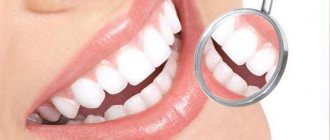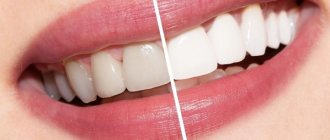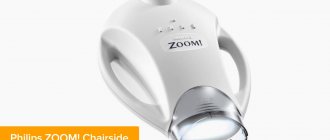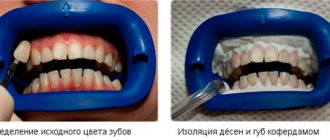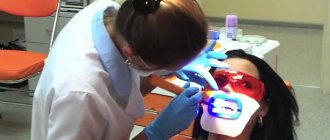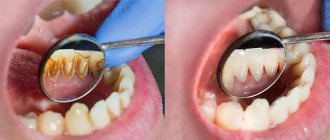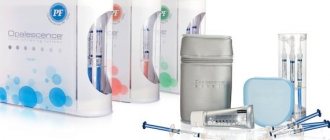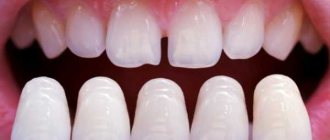Are you still embarrassed to smile? Now all complexes regarding the color of teeth can be left in the past! After all, now there is the latest American system for teeth whitening in just 45 minutes.
Sofi-Dent dentistry offers the most modern, patented, effective, painless and affordable whitening system, which is in great demand in Europe and the USA. The newest American teeth whitening system in just 45 minutes.
Dental centers offer a huge number of services both in the medical field and in the field of aesthetics. Teeth whitening procedures have gained widespread popularity in recent years. Among them, the innovative Amazing White technology deserves special attention. This fast and effective method of teeth whitening is used not only among adults, but also among teenagers, and allows you to whiten teeth 6-8 shades lighter.
The main advantages of AMAZING WHITE whitening technology
- The gentle procedure gently whitens teeth, due to the fact that the whitening gel does not contain aggressive components. Oxygen whitening occurs due to the heating of a special LED lamp “AMAZING WHITE Pluslit Series III” (made in America) and the reaction of splitting peroxide into hydrogen (this allows you to expand the pores of tooth enamel) and oxygen (it penetrates open pores, whitening dark places and cleanses their);
- The entire procedure takes approximately 45 minutes;
- Teeth become lighter by about 6-8 tones;
- The whitening gel contains a minimal amount of hydrogen peroxide;
- The procedure is painless and has no adverse reactions.
Advantages
The method is gaining popularity because it has advantages that distinguish it from others:
- in one session, the enamel brightens by 9–10 shades on the Vita scale;
- the patient does not feel pain during the procedure;
- the session takes 40 minutes;
- the enamel is not damaged;
- there is no danger of touching soft tissues (gums, lips, mucous membranes);
- the effect lasts up to 2–3 years.
Operating principle: under the influence of lamp light, oxygen is released from the gel applied to the teeth. It fights bacteria and destroys plaque.
Having experienced teeth whitening with active oxygen once, the patient will return to it in the future, because at a relatively low price the method quickly brings the desired result and has a minimum of side effects.
How long does the whitening effect last?
It is completely natural that after teeth whitening, new plaque will appear. The process of darkening the enamel itself takes a very long time. But it accelerates significantly if you consume coloring products such as coffee, tea, Coca-Cola, red wine, beets, etc.
Two factors influence how long the results last: your lifestyle and the permeability of your enamel. If you consume foods with coloring agents every day, you will significantly reduce your whitening results. If you have increased enamel permeability, then eating food with dyes will cause your teeth to yellow faster. Alas, it is impossible to know in advance what degree of permeability of tooth enamel you have.
Conclusion: if you have increased permeability of tooth enamel, and at the same time you often use dyes, then the whitening effect will last about six months. If you take little of the above substances and your teeth have low permeability, then whitening performed in the clinic will last for about two years.
Types of whitening ZOOM
As a result of the constant development of ZOOM teeth whitening technology, new versions of the system have appeared. Dental patients are often faced with the problem of choosing between teeth whitening with a ZOOM, ZOOM-2, ZOOM-3 and ZOOM-4 lamp. It should be said right away that all versions are equally effective. Therefore, the final result of the procedure will mainly depend on the characteristics of the dental tissues and their original color. However, some nuances are still worth paying attention to. For example, the ZOOM-2 teeth whitening device differs from its previous version in the length of the light wave. And the longer it is, the less time it takes to carry out one stage of the procedure. As for teeth whitening technologies ZOOM-3 and ZOOM-4, they have slightly more advantages compared to previous versions.
- In the process of teeth whitening ZOOM-3 and ZOOM-4, only original instruments and reagents are used.
- To activate the gel, a special Philips ZOOM device is used with a minimum service life, which makes the whitening procedure even safer.
- The content of hydrogen peroxide in the bleaching product has become less - only 25% without loss of effectiveness. In previous versions, the percentage of the substance reached 35. Thus, the ZOOM-3 system, like teeth whitening ZOOM-4, provides more gentle lightening of tooth enamel.
How to prepare for this procedure
- It is necessary to consult a dentist-therapist. The doctor should examine the oral cavity. Identify diseases of the teeth and gums that are an obstacle to teeth whitening. The doctor finds out why the color of the teeth has changed.
- The dentist works to eliminate the identified problems. Sometimes the doctor can fill teeth damaged by caries with a special gel. Which is removed after bleaching is completed before the immediate installation of fillings. Fillings are selected in accordance with the new color of the teeth. After the teeth have been completely treated and whitened, you can begin to polish them. This increases the effectiveness of whitening using Amazing White technology
Stages
Before the doctor decides to perform the procedure, he asks the patient about diseases and allergic reactions. Then prepares the oral cavity:
- identifies foci of caries, treats;
- treats periodontal diseases, if any are detected;
- replaces old fillings that have darkened or do not adhere well to the tooth surface.
Finally, the dentist will clean your teeth using ultrasound. It removes soft and hard deposits to prevent the appearance of new carious and inflammatory lesions.
Finally the preparation is complete.
The second stage begins - the whitening procedure itself. It includes:
- applying gel;
- use of LED lamp;
- rinsing off the gel and treating the teeth with a paste that protects the enamel from demineralization.
Often a three-time procedure is required (in one session). Each mini-stage lasts 15 minutes.
The patient then receives oral care recommendations and goes home. Weak sensitivity to cold and hot sometimes lasts for a couple of hours, then goes away.
Teeth whitening prices
| Teeth whitening | |
| Services list | Price |
| Removing dental plaque with “DetartrineZ” paste (paste with abrasive zircon crystals, 1 tooth) | 250 |
| Ultrasonic removal of supragingival and subgingival dental plaque in the area of the 1st tooth | 200 |
| Removing soft plaque using the “Air-flow” method (1 tooth) | 300 |
| Deep fluoridation of tooth enamel | 150 |
| Remineralization of enamel “APADENTPRO” (1 tooth) | 250 |
| Clinical whitening “OpalescenceBoost” 40% (2nd jaw in the smile line) | 18 500 |
| Professional clinical whitening “Amazing-White” (USA, 45 min, 2 jaws in the smile line) | 17 500 |
| Home whitening “Opalescense” | 9 500 |
| Intra-canal whitening of the 1st tooth | 2 500 |
| Making individual trays for home whitening (from one jaw) | 6 000 |
| “Skyce” fixation (1 tooth) | 4 500 |
| Professional clinical whitening “ZOOM-4 WHITESPEED” (2 jaws in the smile line) | 30 000 |
How to remove a gap between teeth
The main task that a dentist faces when solving the problem of diastema is to achieve the most even alignment of the central incisors. Depending on the chosen method, this process may take 2-3 dental procedures or last several years (the duration of treatment depends on the complexity and causes of the problem, the age of the patient and other factors).
Modern dentistry offers as many as 10 progressive methods of combating the gap between the front teeth:
- Surgical plastic surgery.
- Bracket systems.
- Records.
- Veneers.
- Lumineers.
- Cosmetic correction.
- Artistic restoration.
- Crowns.
- Implants.
- Mouthguards.
It would not be superfluous to study in detail the features of each technique, comparing their effectiveness and other characteristics.
Surgical plastic surgery
This method is used in the case of a congenital defect associated with an incorrect position of the labial frenulum (it is because of this that the incisors cannot close correctly). Surgical plastic surgery of the frenulum will not remove the gap, but will create conditions under which the teeth will be able to take the correct position. And after this, the dentist selects an effective method of correction. This technique has several nuances related to the patient’s age:
- This procedure is most effective for children 5-8 years old - after the operation, the incisors will close on their own without additional dental intervention.
- After surgery, older patients will be forced to wear orthopedic structures (some of which are fixed not temporarily, but permanently).
The plastic surgery itself is safe for health and painless. Does not require long time for rehabilitation and recovery.
Bracket systems
They are non-removable orthodontic structures designed to straighten the dentition. Parts of the structure are fixed directly on the teeth (from the outside or inside). The use of braces to eliminate gaps between teeth has its own nuances:
- The method is most effective for patients under 16 years of age, when the jaw tissue is not yet fully formed. For older patients, wearing braces may not help (depending on the individual characteristics of the problem).
- The duration of treatment can be up to three years. Braces cannot be removed until the end of the period prescribed by the doctor. In addition, regular visits to the dentist are required (to tighten the braces and change the arches).
It is worth noting that to eliminate a diastema, it will not be possible to place braces only on the incisors - the structure is installed on the entire dentition at once.
Records
One of the most affordable and effective methods for correcting interdental space. These removable structures are made of high-quality plastic and are secured to the teeth using screws, hooks and springs. Due to the created load, the incisors are gradually attracted to each other. The features of this technique include the following facts:
- Efficacy is guaranteed in patients under 12 years of age. It is up to this age that the bone tissue of the jaws is perfectly amenable to correction.
- The plates are not able to cope with significant defects. For example, when the gap is caused by serious dental diseases.
It is worth keeping in mind that, in fact, the plates do not move the teeth like braces, but simply hold them in a given position.
Veneers
Installing veneers can be considered the most efficient option for solving the problem with a chip. They are thin ceramic plates that are used to cover the front surface of teeth. That is, formally the gap is not removed, but closed. The procedure has its own characteristics:
- Veneers do not correct, but disguise the gap, therefore they are suitable only for those cases where the diastema is not a medical, but an aesthetic defect.
- Average service life is about 10 years. After this, the veneers will have to be changed.
- Before installing veneers, a small grinding of the incisors will be required.
Ceramic plates come in a variety of colors, so you can choose ones that will not differ from natural enamel.
Lumineers
Orthopedic onlays are as similar as possible to veneers, but thinner. They are also fixed on the teeth, closing the gap. Features include:
- longer than veneers, service life - up to 20 years;
- installation does not require extensive grinding of teeth.
As in the case of braces, lumineers do not solve, but mask the problem. In addition, they are not suitable for everyone, so you need to pay attention to the list of contraindications.
Cosmetic correction
A budget option that allows you to get quick results. The essence of the procedure is that the gap between the teeth is filled with a filling, which makes the diastema visually invisible. This correction is safe for health, painless and is carried out in one visit to the dentist. The features include the following facts:
- the problem is solved temporarily - the seal has a relatively short service life (5-7 years), so it will need to be replaced;
- The filling material changes color over time, which visually begins to differ from the native enamel;
- There is a risk of developing caries at the junction of the incisors.
Those who choose cosmetic correction to eliminate the gap will have to control the load on the “units” so that the filling remains unchanged and does not break.
Artistic restoration
The method is similar to cosmetic correction, but guarantees a longer lasting result. Using composite materials, the dentist builds up the tissue of the front teeth, closing the gap. As a result, the visual impression is created that the incisors are tightly closed. Features of artistic restoration:
- the most natural appearance after the procedure (photopolymers are matched to the color of the native enamel);
- Just one visit to the dentist is enough to get the desired result;
- the procedure is safe for health and has no contraindications.
The main similarity with cosmetic correction is that after artistic restoration you will also have to control the load on the incisors when eating.
Crowns
Plastic, ceramic or metal-ceramic crowns perfectly solve the problem of diastema. In this case, the cap-shaped design completely covers the teeth (in the case of a gap, it is necessary to apply crowns to both) and does not stand out in any way in the row. Features of installing crowns:
- average service life 10-15 years (depending on the material);
- safe for health;
- preliminary turning of the cutters is required.
The installation of crowns for diastema is not used as often as other methods.
Implants
Implantation is used if the cause of the gap between the incisors is the absence of one or more teeth in a row. Filling the empty spaces will not allow the “ones” to continue to “spread out.” But, even if the dentition is replenished, the gap will remain and will have to be eliminated using some other of the listed methods.
Mouth guards
They are removable orthopedic structures that are manufactured using 3D technology. They look like original “cases” that are put on the teeth and are visually invisible. The mouthguard creates pressure, forcing the “ones” to move in the desired direction, which leads to their closure.
The duration of use of mouth guards (depending on the complexity of the problem) is from three months to three years. During this period, sequential replacement of the aligners is carried out, carried out as the “ones” move. From time to time, the mouthguards are allowed to be removed.
How to minimize sensitivity?
The very first thing that is important to do before whitening if the enamel is very sensitive:
- Two weeks before the procedure, start cleaning your mouth with a paste that blocks the appearance of pain.
- Start brushing your teeth with a soft-bristled brush. Avoid back-and-forth movements, which wear away enamel and damage soft gum tissue. Move in a circle, applying the desensitizing paste, rubbing it into the enamel. The oral cavity is rinsed with water.
- You will need to purchase special mouthguards. They are filled with a product that will relieve hyperesthesia.
The second thing you need for optimal whitening is choosing a safe method. There are a number of measures used to restore your smile to its purity and whiteness. There are professional techniques and traditional medicine.
Professional Method:
- A gel is used, which is activated under the influence of a light beam (laser exposure);
- Application of halogen light (photobleaching).
Among the safe folk remedies:
- Rubbing the enamel with lemon peel (can be used no more than once a week);
- Tea tree oil. Cleaning the enamel with oil is carried out for 30 days.
There are techniques that lead to side effects. Among them:
- Oxygen bleaching. In this case, the enamel is affected with the help of peroxide and its derivatives;
- Air Flow. Exposure to water + small abrasive particles;
- Active substances of the gel used in chemical bleaching.
Proper oral care
To get the maximum effect from the whitening procedure, it is important to adhere to the following rules:
- Avoid drinking hot/cold drinks. Typically, such dissonance leads to cracks in the enamel and increased sensitivity;
- Care involves the use of threads and a brush with soft bristles. You need to remove plaque with circular movements, and not by friction “back and forth”;
- It is important to undergo remineralization. To do this, use products rich in fluoride. They relieve pain;
- Chewing gum that you use to freshen your breath or clear plaque after eating should be sugar-free.
If sensitivity bothers you for several days after whitening, contact the clinic, where they will determine the cause and relieve you of pain.
The essence of the in-office whitening procedure
Enamel whitening in the dentist’s office by any method follows a single algorithm:
- The doctor examines the oral cavity for contraindications. If they are absent, he begins to apply a protective composition to the gums.
- A whitening compound is applied to the front surface of the teeth. Gels are not used when ultrasonic cleaning and Air Flow technology are used.
- Depending on the type of whitening, teeth are exposed to a halogen or LED lamp emitting ultraviolet light, or a laser.
- The bleaching composition is washed off and the previous step is repeated if necessary.
Finally, a remineralizing composition is applied to the teeth.
